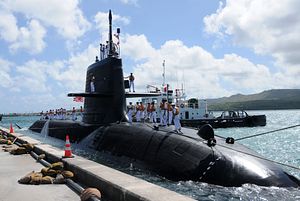A bilateral military exercise has brought a Japanese submarine into Australian waters in Sydney for the first time since WWII.
The Nichi Gou Trident exercise, a joint naval drill between the two countries that has been conducted since 2009, seeks to enhance their naval ties by honing maritime practices and improving interoperability.
As part of the exercises, the Japanese Maritime Self Defense Force and the Royal Australian Army have gathered in Sydney Harbor for the first time this week before heading out for a week of drills.
“This is the first opportunity to conduct the exercise off Sydney,” the Australian defense ministry said in an April 15 statement seen by The Diplomat.
The Japanese submarine JS Hakuryu (SS 503), along with two JMSDF destroyers JS Umigiri (DD158) and JS Asayuki DD132) are taking part in the exercises. On the Australian side, the HMA Ships Ballarat, Adelaide and Success are participating in the exercise along with aviation elements including the Navy’s 816 Squadron’s S-70B Seahawks and the Air Force’s AP-3C Orion and Hawk 127 aircraft.
Of the participating Japanese vessels, Hakuryu in particular has received significant attention for two reasons. Firstly, this is the first time that a Japanese submarine has docked in Sydney since WWII, when both countries were fighting on opposite sides.
Japan’s last submarine visit to Australia was in 1942. In May that year, several Japanese submarines entered the harbor, with two of them eventually sunk following an attack on HMAS Kuttabul which killed 21 sailors.
“I can say with confidence a Japanese submarine’s first visit to Sydney in 74 years is proof that the relationship between our two navies has fully developed into a mature, trusting one, that our predecessors would never have expected 74 years ago,” Chief of Staff and Commander Fleet Escort Force Rear Admiral Ryo Sakai told reporters according to the Australian Broadcasting Corporation (ABC).
Secondly, the Hakuryu is a Soryu-class submarine that is of the same type that Japan has offered Australia to replace its fleet of aging Colins-class submarines in a high-profile deal reported on extensively, including here at The Diplomat. Though both Japanese and Australian officials have repeatedly pointed out that the submarine’s inclusion is unrelated to the bid, with a final decision on the contract expected in just weeks, the timing has understandably turned heads. France and Germany have also submitted bids for the contract, which is to build 12 new submarines for Canberra that are expected to cost at least $50 billion.
The previous iteration of Nichi Gou Trident was held in Japan in October 2015.































